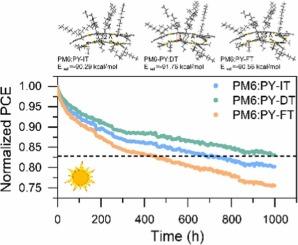分子排序使全聚合物太阳能电池在变温环境下高效稳定运行
IF 17.1
1区 材料科学
Q1 CHEMISTRY, PHYSICAL
引用次数: 0
摘要
全聚合物太阳能电池(all-PSC)近年来取得了巨大的进展。然而,聚合物链纠缠的复杂性给改善载流子传输和光电压增益带来了障碍,从而提高了光伏性能。本研究基于a -D-A ' -D-A型聚合物受体(PY-IT, PY-DT和PY-FT)与聚合物供体PM6共混物,研究了全pscs的分子结构-电压损耗-器件稳定性关系。我们发现聚合物受体的构象刚性在减少共混物中与输运相关的能量紊乱(σ)和光电压损失的非辐射重组(ΔVnon-rad)中起决定性作用。值得注意的是,PM6:PY-DT异质结实现了低σ (0.281 eV),从而实现了低ΔVnon-rad (0.183 V)、高填充因子(78.34)和19.26%的PCE。我们进一步表明,全聚合物异质结中减少的能量和分子无序可以导致在光照下热和动力学更稳定的相形态。结果,ΔVnon-rad在光浸泡下的生长受到抑制,使器件在1000小时的MPP跟踪和5个热循环(205-353 K)后分别保持其初始PCE的83%和91.9%。这些发现为在实际应用中同时提高有机太阳能电池的效率和稳定性提供了指导。本文章由计算机程序翻译,如有差异,请以英文原文为准。

Molecular Ordering Enables High efficiency and Stable All-Polymer Solar Cells Operated in Temperature-Variable Environment
All-polymer solar cells (all-PSC) have received vast progress recently. However, the complexity of polymer chain entanglements imposes barrier for improving charge carrier transport and photovoltage gains toward higher photovoltaic performance. Here, we present a study on molecular structure-voltage loss-device stability relationships in all-PSCs based on a group of A-D-A’-D-A type polymer acceptors (PY-IT, PY-DT and PY-FT) in blends with the polymer donor PM6. We show that the conformational rigidify of polymer acceptor plays a decisive role in reducing transport-related energetic disorder (σ) in blends and non-radiative recombination (ΔVnon-rad) for photovoltage loss. Notably, the PM6:PY-DT heterojunction achieves a low σ (0.281 eV), resulting in a low ΔVnon-rad (0.183 V), a high fill factor (78.34), and a PCE of 19.26%. We further show that the reduced energetic and molecular disorder in the all-polymer heterojunction can lead to a phase morphology that is thermally and kinetically more stable under illumination. As a result, ΔVnon-rad growth under light-soaking is suppressed, enabling devices to retain 83% and 91.9% of their initial PCE after 1000 hours of MPP tracking and five thermal cycles (205–353 K), respectively. These findings offer guidance for simultaneously improving efficiency and stability in organic solar cells toward practical applications.
求助全文
通过发布文献求助,成功后即可免费获取论文全文。
去求助
来源期刊

Nano Energy
CHEMISTRY, PHYSICAL-NANOSCIENCE & NANOTECHNOLOGY
CiteScore
30.30
自引率
7.40%
发文量
1207
审稿时长
23 days
期刊介绍:
Nano Energy is a multidisciplinary, rapid-publication forum of original peer-reviewed contributions on the science and engineering of nanomaterials and nanodevices used in all forms of energy harvesting, conversion, storage, utilization and policy. Through its mixture of articles, reviews, communications, research news, and information on key developments, Nano Energy provides a comprehensive coverage of this exciting and dynamic field which joins nanoscience and nanotechnology with energy science. The journal is relevant to all those who are interested in nanomaterials solutions to the energy problem.
Nano Energy publishes original experimental and theoretical research on all aspects of energy-related research which utilizes nanomaterials and nanotechnology. Manuscripts of four types are considered: review articles which inform readers of the latest research and advances in energy science; rapid communications which feature exciting research breakthroughs in the field; full-length articles which report comprehensive research developments; and news and opinions which comment on topical issues or express views on the developments in related fields.
 求助内容:
求助内容: 应助结果提醒方式:
应助结果提醒方式:


